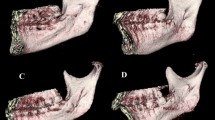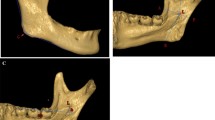Abstract
Objective
The purpose of this article was to assess the anatomical relationship between the lingula and the antilingula by measuring the projection of lingula on the lateral side of the ramus on CBCT.
Methods
This study collected CBCT images of 204 mandibular halves in 102 Chinese patients without any damage. We projected the lingula to the lateral side of the mandibular ramus and examined the distance and position relationship between the projection point and the antilingula using three-dimensional computed tomography (3DCT) created by image software.
Results
In 204 sides the antilingula appeared in 92 cases, 52 on right and 40 on left. The antilingula was used as a fixed point, in four cases the lingula projection in the anterior superior part, 38 cases in the posterior superior part, 45 cases in the posterior inferior part and zero case in the anterior inferior part. Scatter plots diagrammatic representation in four quadrants centered on the antilingula showed that 79% cases (73/92) lied in a 90° fan shape ranged in 5–10 mm radius in the posterior superior and inferior quadrant.
Conclusion
The lingula mainly located in the posterior superior and inferior part from the antilingula in a 90° fan shape ranged in 5–10 mm radius. The osteotomy incision should be avoided in this area.



Similar content being viewed by others
References
Alves N, Deana NF (2015) Morphological study of the lingula in adult human mandibles of Brazilians individuals and clinical implications. Biomed Res Int 2015:1–7
Apinhasmit W, Chompoopong S, Jansisyanont P, Supachutikul K, Rattanathamsakul N, Ruangves S, Sangvichien S (2011) The study of position of antilingula, midwaist of mandibular ramus and midpoint between coronoid process and gonion in relation to lingula of 92 Thai dried mandibles as potential surgical landmarks for vertical ramus osteotomy. Surg Radiol Anat 33:337–343
Aziz SR, Dorfman BJ, Ziccardi VB, Janal M (2007) Accuracy of using the antilingula as a sole determinant of vertical ramus osteotomy position. J Oral Maxillofac Surg 65:859–862
Caldwell JB, Letterman GS (1954) Vertical osteotomy in the mandibular raml for correction of prognathism. J Oral Surg 12:185–202
Hayward J, Richardson ER, Malhotra SK (1977) The mandibular foramen: its anteroposterior position. Oral Surg Oral Med Oral Pathol 44:837–843
Hogan G (2006) The “antilingula"—fact or fiction? J Oral Maxillofac Surg 64:1248–1254
Jin HP, Jung HD, Kim HJ, Jung YS (2018) Anatomical study of the location of the antilingula, lingula, and mandibular foramen for vertical ramus osteotomy. Maxillofac Plast Reconstr Surg 40:15–20
Kositbowornchai S, Siritapetawee M, Damrongrungruang T, Khongkankong W, Chatrchaiwiwatana S, Khamanarong K, Chanthaooplee T (2007) Shape of the lingula and its localization by panoramic radiograph versus dry mandibular measurement. Surg Radiol Anat 29:689–694
Mamatha H, Vrinda Hari A, Antony Sylvan DS, Chenna D, Anne DS (2015) The study of antilingula and its relation to the lingula and mandibular foramen, the presence of mylohyoid bridging in dry mandibles of South Indian population. J Maxillofac Oral Surg 14:1–4
Min L, Lai G, Zhi-yong Z, Chang-sheng L, Lu-ping H, Feng N, Ji J (2006) Intraoral approach for the correction of prominent mandibular angle. Chin J Med Aesth Cosmet 12:323–327
Pogrel MA, Schmidt BL, Ammar A (1995) The presence of the antilingula and its relationship to the true lingula. Br J Oral Maxillofac Surg 33:235–238
Sekerci AE, Sisman Y (2014) Cone-beam computed tomography analysis of the shape, height, and location of the mandibular lingula. Surg Radiol Anat 36:155–162
Tamás F (1979) The groove of the mandibular neck as a risk factor in vertical osteotomy of the ramus of the mandible. Int J Oral Surg 8:1–7
Trost O, Salignon V, Cheynel N, Malka G, Trouilloud P (2010) A simple method to locate mandibular foramen: preliminary radiological study. Surg Radiol Anat 32:927–931
Yates C, Olson D, Guralnick W (1976) The antilingula as an anatomic landmark in oral surgery. Oral Surg Oral Med Oral Pathol 41:705–708
Yu G, Matsumura T, Yanagi Y, Moritani N, Iida S (2015) Anatomical relationship between the mandibular foramen and the lateral surface shape of the mandibular ramus using CT. J Oral Maxillofac Surg Med Pathol 27:614–623
Zhou C, Jeon TH, Jun SH, Kwon JJ (2017) Evaluation of mandibular lingula and foramen location using 3-dimensional mandible models reconstructed by cone-beam computed tomography. Maxillofac Plast Reconstr Surg 39:30–36
Acknowledgements
This work was supported in part by A Project Funded by the Priority Academic Program Development of Jiangsu Higher Education Institutions (PAPD, 2018-87). The Project of Invigorating Health Care through Science, Technology and Education (Jiangsu Provincial Medical Youth Talent QNRC2016852), Jiangsu Provincial Medical Innovation Team (CXTDA2017036) and sponsored by Qing Lan Project.
Author information
Authors and Affiliations
Contributions
KZ and YH carried out the experiments and drafted the manuscript; BZ and RW were involved in the statistical analysis; RW and HY critically reviewed the manuscript; HY managed the experimental design, reviewed the manuscript and provided funding support. All authors read and approved the final manuscript.
Corresponding author
Ethics declarations
Conflict of interest
The authors declare that they have no conflict of interest.
Additional information
Publisher’s Note
Springer Nature remains neutral with regard to jurisdictional claims in published maps and institutional affiliations.
Rights and permissions
About this article
Cite this article
Zhao, K., Hou, Y., Zhang, B. et al. CBCT study on the relationship between lingula and antilingula position in a Chinese Han population. Surg Radiol Anat 41, 663–667 (2019). https://doi.org/10.1007/s00276-019-02224-9
Received:
Accepted:
Published:
Issue Date:
DOI: https://doi.org/10.1007/s00276-019-02224-9




